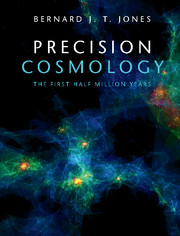Book contents
- Frontmatter
- Dedication
- Contents
- Preface
- Notation and Conventions
- Part I 100 Years of Cosmology
- Part II Newtonian Cosmology
- Part III Relativistic Cosmology
- Part IV The Physics of Matter and Radiation
- Part V Precision Tools for Precision Cosmology
- 23 Likelihood
- 24 Frequentist Hypothesis Testing
- 25 Statistical Inference: Bayesian
- 26 CMB Data Processing
- 27 Parameterising the Universe
- 28 Precision Cosmology
- 29 Epilogue
- Appendix A SI, CGS and Planck Units
- Appendix B Magnitudes and Distances
- Appendix C Representing Vectors and Tensors
- Appendix D The Electromagnetic Field
- Appendix E Statistical Distributions
- Appendix F Functions on a Sphere
- Appendix G Acknowledgements
- References
- Index
27 - Parameterising the Universe
from Part V - Precision Tools for Precision Cosmology
Published online by Cambridge University Press: 04 May 2017
- Frontmatter
- Dedication
- Contents
- Preface
- Notation and Conventions
- Part I 100 Years of Cosmology
- Part II Newtonian Cosmology
- Part III Relativistic Cosmology
- Part IV The Physics of Matter and Radiation
- Part V Precision Tools for Precision Cosmology
- 23 Likelihood
- 24 Frequentist Hypothesis Testing
- 25 Statistical Inference: Bayesian
- 26 CMB Data Processing
- 27 Parameterising the Universe
- 28 Precision Cosmology
- 29 Epilogue
- Appendix A SI, CGS and Planck Units
- Appendix B Magnitudes and Distances
- Appendix C Representing Vectors and Tensors
- Appendix D The Electromagnetic Field
- Appendix E Statistical Distributions
- Appendix F Functions on a Sphere
- Appendix G Acknowledgements
- References
- Index
Summary
It has been found that six parameters are sufficient to describe the physical properties of our Universe. All the other parameters can be derived from these. These are derived from the power spectra of the temperature and polarisation maps of the CMB sky. The characteristic shapes of these curves are the signature of the Universe.
We need to understand how we go from the CMB map to the power spectrum. This involves the spherical analogue of Fourier analysis, which is the description of the sky in terms of Legendre functions and their generalisations.
The power spectra have strong features that are sensitive to different combinations of the cosmological parameters. This means that we can determine the parameters as accurately as the noise in the power spectrum allows. Of the two polarisation modes, E and B, the discovery of the B-mode will yield information about a seventh parameter that will measure the gravitational waves that would have come from the earliest moments of the Universe, the period of inflation, if there was one.
The Cosmic Parameter Set
Cosmology was described by Sandage (1970) as ‘a search for two numbers’, the Hubble constant, H0, and the deceleration parameter, q0. Neither was known to within a factor of two. It is astonishing that we now believe we can determine almost a dozen parameters, some with a precision of around 10%, and many to better than 1%. We have come to the era of precision cosmology, in which large groups of scientists handle vast data sets using sophisticated models and statistical techniques.
The possibility of accurately determining the values of the cosmological parameters that define our Universe merely by using the observations of the Cosmic Microwave Background (CMB) is quite extraordinary. We do not have to observe the expansion of the system of galaxies, we do not even have to know their distances: the CMB alone can tell us most of the things that define our Universe at large.
Having said that, we shall see that other entirely independent data sets, based on the distribution of galaxies and on the expansion of the Universe as measured by observations of Type Ia Supernovae, serve to provide quite independent and very accurate corroborating measures of these parameters.
- Type
- Chapter
- Information
- Precision CosmologyThe First Half Million Years, pp. 634 - 644Publisher: Cambridge University PressPrint publication year: 2017



